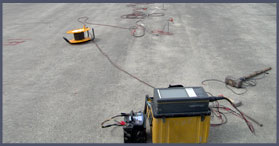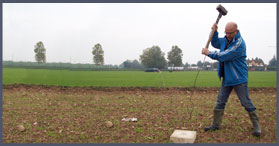The determination of
Vs30 (the average shear waves propagation velocity in the first 30 meters of depth) is very important for soil definition and classification in compliance to the new law concerning the prevention against earthquakes.
For this evaluation, in addition to borehole seismic (downhole, crosshole) and surface seismic (S waves refraction and reflection), alternative methods for subsurface modeling based on the analysis of surface waves (Rayleigh) have become more and more popular in the last few years.
Among the other techniques, the microtremors analysis turns out to be particularly efficient, both from the result quality and the economic point of view. In fact, it can be accomplished using operational procedures very similar to those used for conventional surface seismic.
The process consists of transforming seismic recordings into "slowness-frequency" bidimensional spectra; these diagnostics allow us to define, by manual picking, a dispersion curve which is strictly correlated to subsurface shear wave velocity distribution of the investigated areas.
The inversion of this curve allows us to determine the Vs variation with depth and, consequently, to calculate the Vs30 value.


The
MASW, a methodology that was invented by researchers of Kansas Geological Survey (Park et al., 1999), allows us to determine shear waves velocity variations with depth by the analysis of surface waves (Rayleigh) propagation.
The method can be both active and passive:
1. In the
active method surface waves are produced by a surface source and recorded by receivers linearly deployed on the ground
2. In the
passive method what is recorded are microtremors generated by natural or anthropic sources (vehicle circulation, industrial activities, etc.)
The above mentioned techniques investigate on different bandwidths; more centered on high frequencies the former (15-80 Hz) and therefore providing information on the shallow part of the subsurface; more targeted on low frequencies (5-20 Hz) is the latter, with the possibility of providing information about deep layers.
The combination of the two techniques allows us to work within a wide spectral bandwidth and therefore to obtain the shear wave velocity trend both for shallow and deep layers.
The analysis and the interpretation process consist of transforming the seismic records into a
phase velocity-frequency bi-dimensional spectrum on which the dispersion curve is manually picked.
By the inversion of the dispersion curve it is possible to determine shear wave velocity Vs variations with depth.